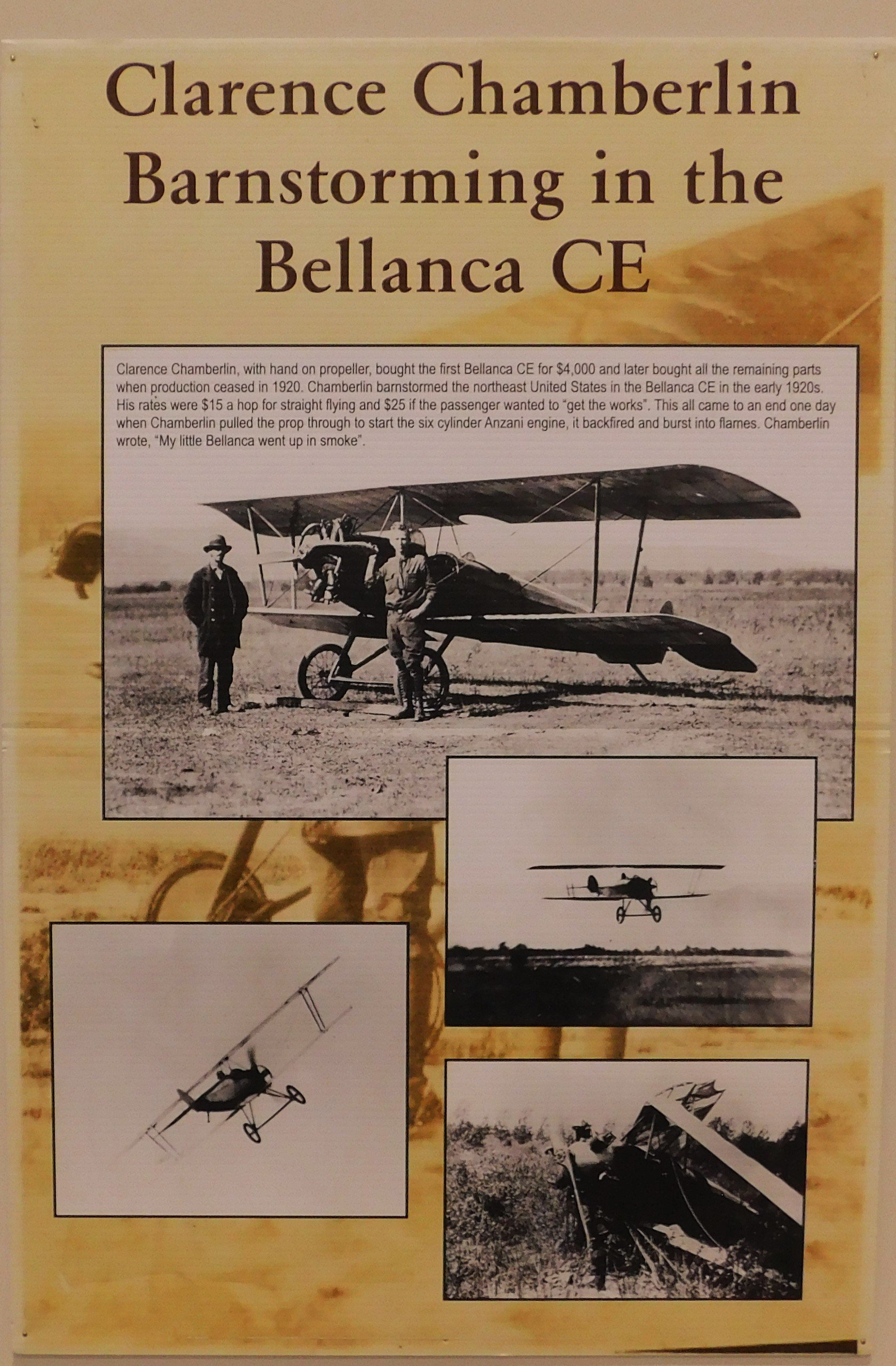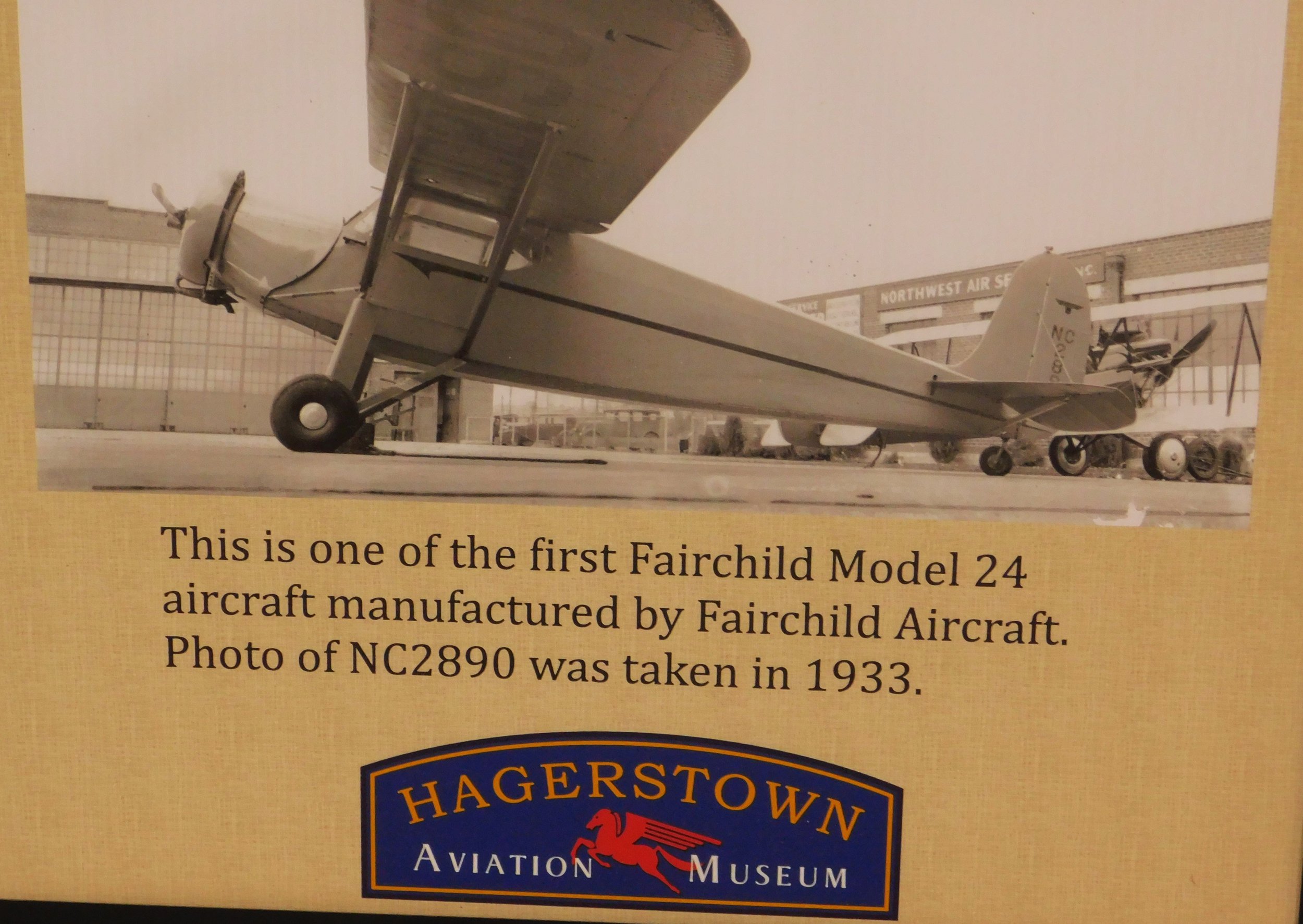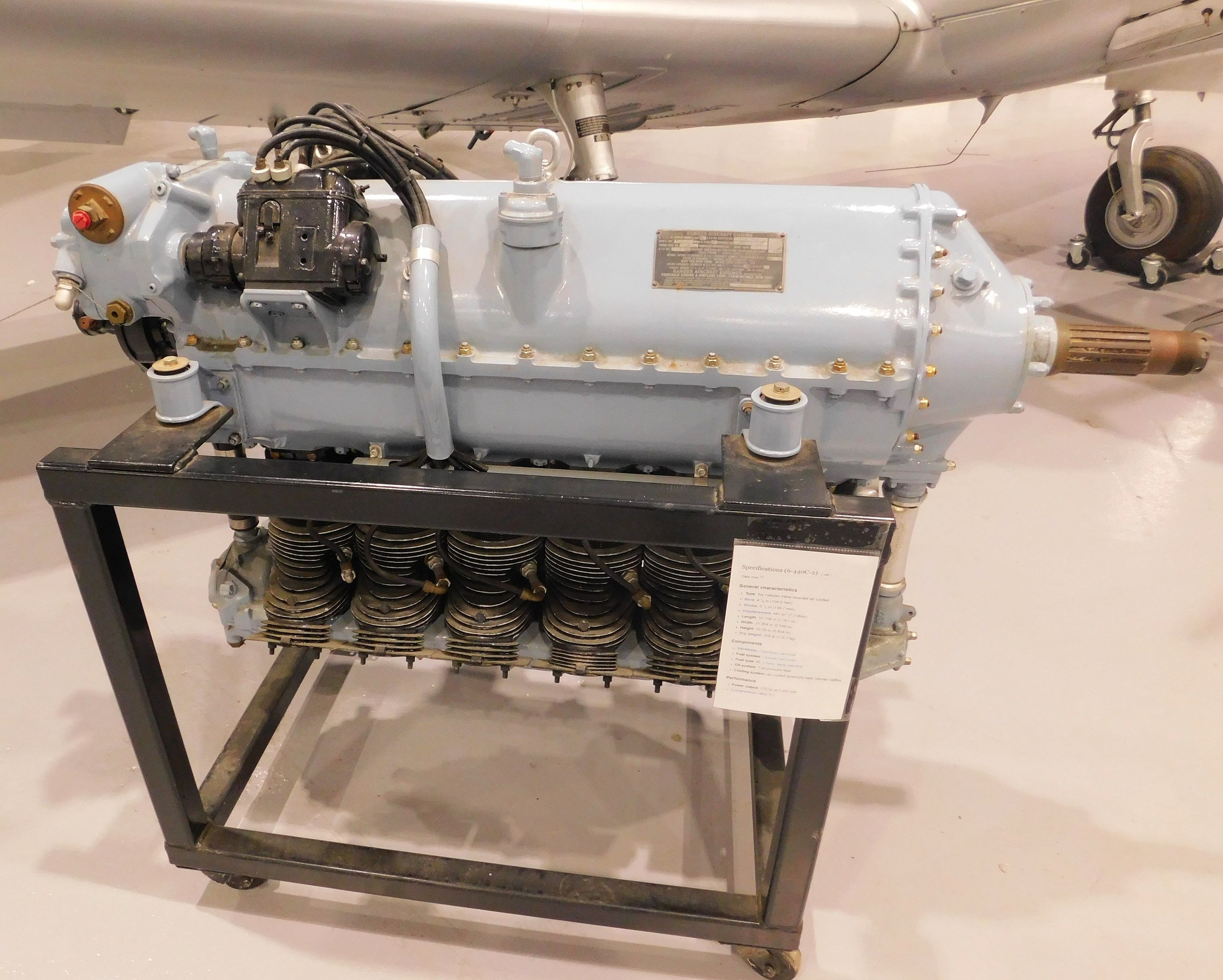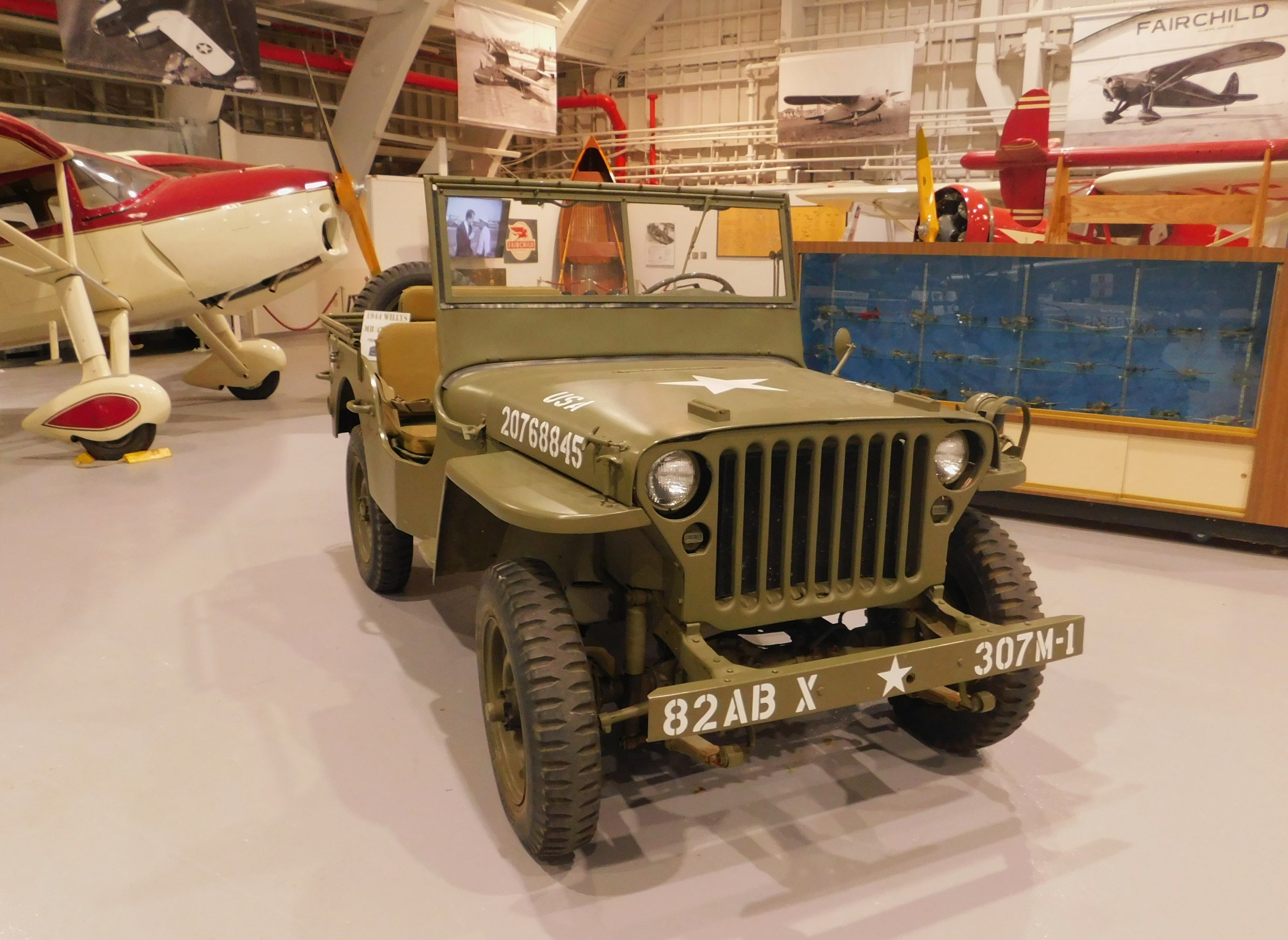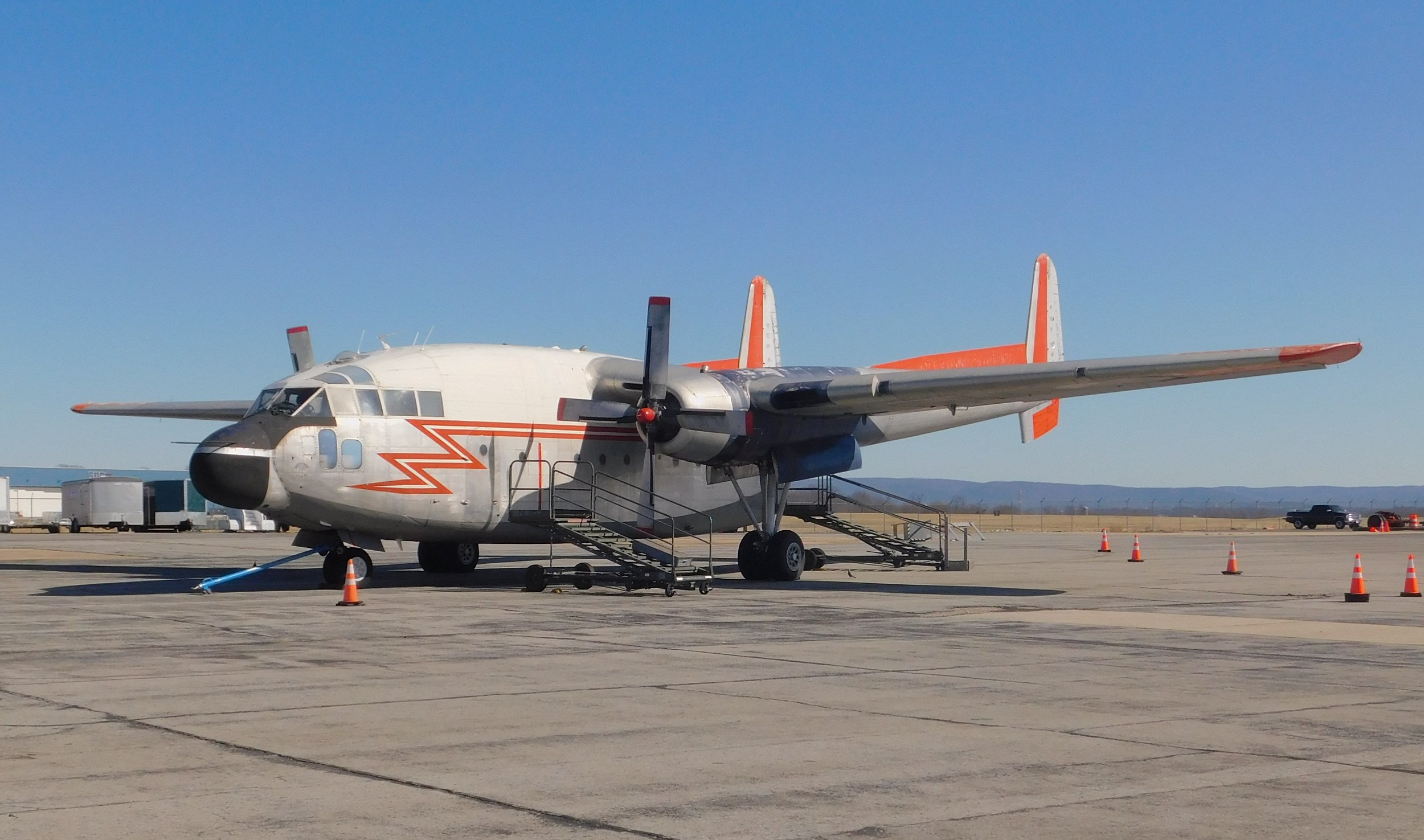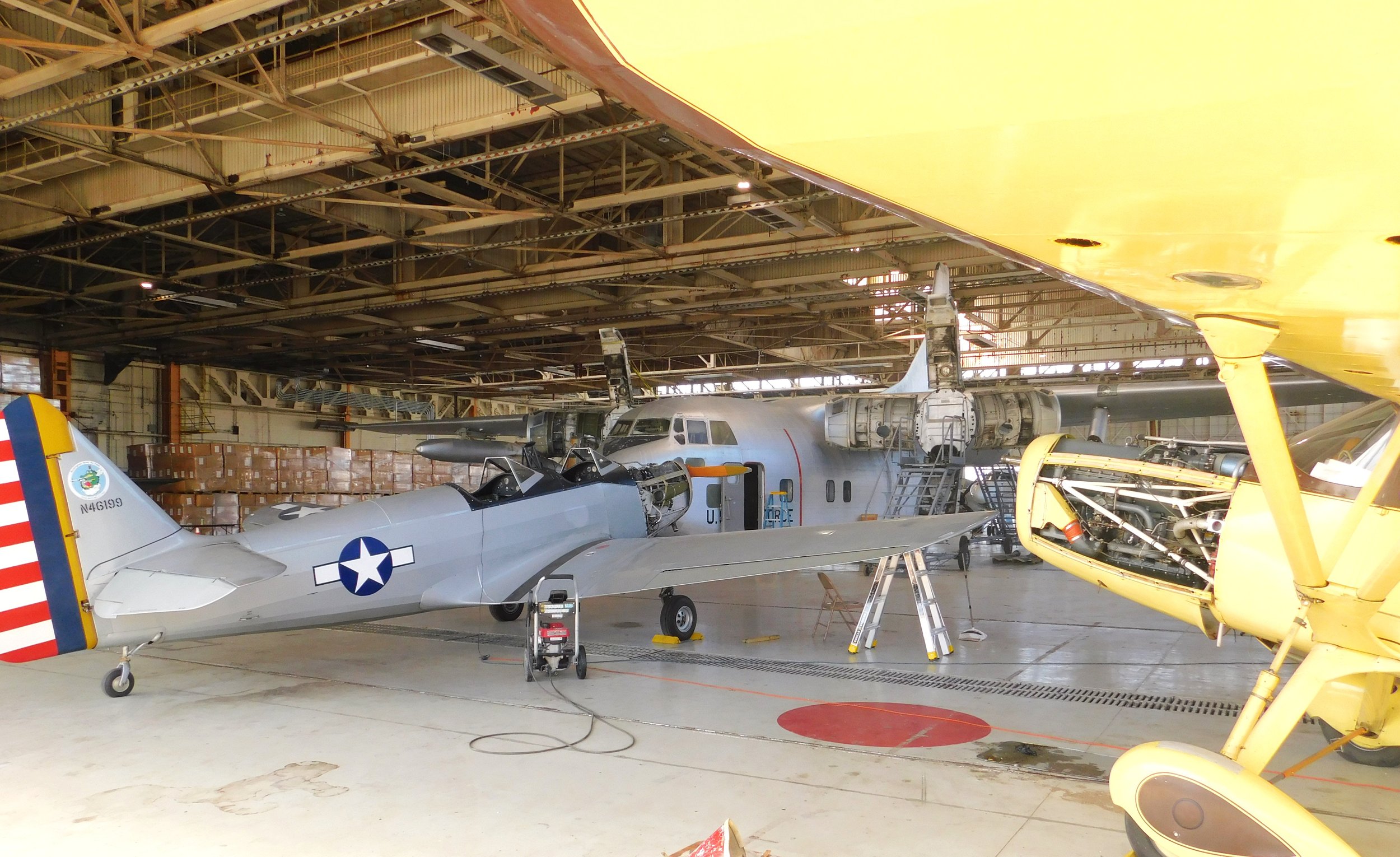Hagerstown Aviation Museum
Issue 52, a visit to Hagerstown Aviation Museum in Hagerstown Maryland, April 2025
Photo courtesy of Hagerstown Aviation Museum
In 1926, after obtaining financing from a group of St Louis businessmen in a quest to win the Orteig Prize, Charles Lindbergh began his search for an aircraft suitable for the attempt at a non-stop Atlantic crossing. Lindbergh travelled to the Wright Aeronautical company in New Jersey in the hope of purchasing a Wright Bellanca WB-2 that had been built specifically for long range flying. A deal was close to being struck when Charles Levine, owner of the rights to the WB-2, made it clear that he would select the pilot for the flight, and it would not be Lindbergh.
The pilot that Levine was planning on hiring was Clarence Chamberlin. Chamberlin learned to fly at the end of WWI, too late to see any action. He was, however, hooked on flying, and as soon as he was discharged, he ordered a Bellanca model CE from famed designer, Giuseppe Mario Bellanca. The two-seat trainer that Chamberlin purchased in 1919 had been designed during WWI, but it never went into production due to the end of the War. The only CE built was built by the Maryland Pressed Steel Company in Hagerstown Maryland.
After several years of barnstorming, Chamberlin’s Bellanca was destroyed by fire during an engine start. He had, however, purchased numerous spare parts and those parts eventually made their way back to Hagerstown. Today, this skeleton, of original parts, is the only remaining example of this early Bellanca design, perhaps the earliest display of an original Bellanca anywhere. It is on display at the Hagerstown Aviation Museum.
Fairchild Aircraft was the center of manufacturing in Hagerstown for many years. The idea for a museum in Hagerstown developed in 1995 during a Fairchild air show. After a display of Fairchild memorabilia generated interest and excitement, a move was made to find a location for a museum. After many years of search, a lease was signed in 2020 for the 1943 Fairchild Aircraft Flight Test hangar. The hangar, known as the Dome hangar, had been abandoned for years and needed a lot of repairs. After a 2022 visit by Maryland Governor Larry Hogan, the museum received a state grant, enough to purchase the hangar as well as shop and ramp space. The grand opening of the current museum was held in December 2023. Although there are exciting plans in the works to increase the museum size, the current museum is a very complete tribute to Fairchild Aviation.
Planes in the attractive and well-lighted 1943 hangar are displayed generally in chronological order. The first plane you come to after the Chamberlain “Bellanca” is this 1928 Kreider-Reisner C-2 Challenger S/N 239.
Amos Kreider and Lewis Reisner founded an FBO in Hagerstown in 1925. They offered repairs and aircraft rebuilds as well as a flying service. They saw a need for a more robust aircraft than the surplus WWI Jennys that were in wide use and, in 1926, they formed a company to build their own design. The result was the 3-place KR C-1 Challenger. They continued to update their planes, mainly through better engines. In 1929, the Kreider-Reisner aircraft company became a subsidiary of Fairchild Aircraft and the updated C-1, the C-2, was renamed the KR-31. This airframe was continuously modified, upgraded, and re-named, with over 100 eventually built.
Next in line is this 1933 Fairchild 24 C8A. The four-seat light transport was popular in a variety of roles, including as an Army Air Corps and RAF transport- with the designation UC-61.
Early models, such as this one, were built with a radial engine while later variations had in-line engines. The in-line engines gave the nose of the aircraft a much different, tapered, profile. A variety of Fairchild (Ranger) and Warner engines were used, with a total of 2232 Model 24s being produced between 1932 and 1948.
Fairchild continually updated the Model 24 over the 16 year production run and many model designations exist. This 1939 24 R-9 has an upgraded Fairchild Ranger engine with 165 HP. A total of 35 of this model were built.
This particular Model 24 was flown as a member of Civil Air Patrol Base 14 in Parksley Virginia during WWII. When the US entered WWII in December of 1941, all civilian flying was banned, except for members of the Civil Air Patrol (which had been formed in December 1941). In early 1942, neither the Navy nor the Coast Guard were spooled up enough to fly coastal patrols against the ever increasing U-Boat activity off the East Coast. Parksley was developed from several farm fields and the first coastal patrol was flown in May 1942, just one month after the establishment of the base. By the end of 1942, the Navy and Coast Guard had fully taken over coastal patrols, but the CAP had provided an invaluable service and the U-Boat activity off the East Coast had greatly decreased.
Sherman Fairchild was not typical of the successful founders of aircraft companies in the 1920s and 30s. Unlike pioneers such as Walter Beech, Clyde Cessna, and William Piper, Fairchild did not grow up in an aviation environment, and was not a pilot. Born in 1896, Fairchild was the son of a congressman and a businessman who specialized in clocks and adding machines. George Fairchild merged his company with several other companies to form IBM and he was that company’s first CEO. Growing up, Sherman was encouraged to tinker with anything mechanical. Although he attended Harvard, the University of Arizona, and Columbia, he didn’t graduate from any of them due to poor health. Prior to WWI he had developed an interest in photography, especially aerial photography, and tried to win a military contract for an aerial camera he invented. The contract didn’t come through but he continued to develop his cameras after the war. He established the Fairchild Aerial Camera Corporation in 1920 and soon received orders for his camera for both military and civilian aerial mapping. After purchasing several aircraft to test his cameras, Fairchild realized that none were stable enough for his purposes. In 1925 he formed the Fairchild Aviation Corporation on Long Island to build the Fairchild FC-1, an aircraft specifically designed to provide a stable platform for accurate aerial mapping and surveying. Fairchild quickly became a dominant aircraft manufacturer with the FC-2, building 300 of the sturdy planes, which were utilized for a number of commercial applications besides mapping.
Sherman Fairchild was an entrepreneur with many business interests other than aviation, which makes it a little difficult to follow the history of Fairchild Aviation. Fairchild sold, repurchased, and reorganized his aircraft holdings several times, changing names in the process. He also manufactured planes in various locations. The purchase of Kreider-Reisner in 1929 seems to have been a stabilizing factor and in 1935, Fairchild Aircraft Corporation settled in Hagerstown Maryland, where it remained until shutting down in 1987. The final Fairchild product that had final assembly in Hagerstown was the A-10 Thunderbolt II. The A-10 prototypes were built and flown on Long Island and various components, such as the wings, continued to be manufactured there throughout the 12 year production run. After the first 10 however, all A-10s had their final assembly in Hagerstown.
One of the better known early Fairchild products is the WWII trainer, the PT-19, two of which are on display in the museum (one is in flying condition).
First flown in 1939, the PT-19 was built with the impending war in mind, and the low-wing trainer was mainly constructed of wood, leading to some durability issues. It was the first monoplane trainer, and the use of a Ranger six cylinder in-line engine gave it better visibility from the cockpit than a radial engine. It was quite successful, with over 7,000 being built.
Displayed next to this 1943 PT-19, USAAF serial number 42-83447, is a restored Ranger engine. The Ranger L-440 was a six-cylinder, inline, inverted, air-cooled aero-engine. It was produced by the Ranger Aircraft Engine Division of the Fairchild Engine and Airplane Corporation in Farmingdale, New York. This version had 175 HP.
Around the museum there are many other interesting and well described displays.
Several displays, of course, are of in-flight cameras.
At spots during a tour of the hangar there are doors leading to the ramp outside. There are several large Fairchild products on display, including this C-82A Packet.
By 1943, the Army Air Corps realized the need for transports larger than the C-46 and C-47. Fairchild’s C-82 was selected and the prototype first flew in September of 1944 in Hagerstown. The C-82 deliveries began in 1945, too late to have any effect during WWII but the need for this size aircraft was realized post-war, and 223 were built from 1944-1948.
This particular Packet, Serial Number 45-57814, was acquired at auction from Hawkins & Powers Liquidation auction in Greybull, Wyoming in 2006 (see Issue 3 for a blog about the museum in Greybull).
As you can see, this is one of a number of C-82s converted by the addition of a jet engine on top of the fuselage. It is a Steward-Davis Jet-Packet 3400 version and this plane was, for a time, operated by TWA as a Flying repair station for its European routes.
Photographer: Charles M. Daniels Collection Notes: At London Heathrow
When it was flown from Greybull to Hagerstown in 2015, it marked the final flight of a Fairchild C-82 Packet.
Next to the C-82 is an example of the better known, and much more successful, Fairchild C-119 Flying Boxcar. Introduced in 1949, 1183 were built during its six year production run. This C-119G, serial number RCAF 22111, was built as a C-119F and then converted to a C-119G for the Royal Canadian Air Force. It flew for the RCAF until 1965, when it went into storage. It spent some time at Greybull, WY in firefighting service. In 1988, it flew in the movie Always. Flying Boxcars flew on in Navy, Air Force, and Marine Reserve squadrons until the mid-1970s.
The third aircraft on the ramp during my visit was this F-27 Friendship, another plane that came from Greybull, WY.
The Fokker F-27 first flew in 1955 and became one of the most successful regional aircraft in Europe. Fairchild signed a licensing agreement with Fokker to build the F-27 in the US (in Hagerstown) and the first US built F-27 flew in 1958. The type also became very successful in the U.S. as a regional aircraft. Fairchild independently designed a stretched version of the F-27 which they designated the FH-227 (by this time, Fairchild had merged with Hiller Aircraft).
Built in 1959, as an F-27 200, this Fairchild had a long and interesting career. It was originally purchased by a Pepsi bottling company in Pittsburgh. In 1961, it was sold to a company in Arizona that made extensive modifications, turning it into an F-27F (freighter). In 1980, interestingly, it began a stint with the US Navy. Bearing BuNo 161628, it was given the designation UC-27A, the only aircraft to ever have that designation. It served as a general transport for several Navy commands from 1980 to 1988. In 1989 it was leased to a diamond mine in Australia, spent some time in Indonesia, and was finally struck from Navy rolls in 1996. In 2000 it was sent to Greybull for storage, went through several owners, spent some time as a display in the Greybull Museum and was donated to the Hagerstown Museum in 2016.
On most days that the museum is open, these ramp aircraft are open to view the interiors.
The Museum has a second hangar that is used for restoration and storage. It is available for viewing with a museum guide. Currently in the design stage for this area is a representation of a factory floor as it looked during WWII. This extensive project is planned to open in late 2025 or early 2026 and should be a great addition to the museum. The new display will be appropriate because the museum is as much a memorial to Hagerstown manufacturing as it is to Fairchild. The two are wrapped up with each other and during WWII it is estimated that 85% of Hagerstown's industrial capacity was involved with producing Fairchild Airplanes.
Anyone who flew during the latter part of the 20th century recalls the ubiquitous Fairchild Metroliner. Used both as a regional and corporate aircraft, the long, thin Metroliner was known to pilots affectionally as the “executive mailing tube”.
Developed from the Swearingen Merlin, a nine-seat corporate aircraft which first flew in 1969, the Metroliner is another one of the complicated business relationships of Fairchild Aircraft. While developing the Metroliner, Swearingen ran into financial problems and Fairchild purchased 90% of the company in 1971. The plane entered service in 1972 as the Fairchild Swearingen Metroliner. True to the Fairchild style, the Metroliner was continuously upgraded in size and performance, with Metroliner II, III, and IV, versions produced, as well as several other variants. All Metroliners were built in the original Swearingen facility in San Antonio although, even before the stock purchase, Fairchild had been building the wings and engine nacelles in Hagerstown.
One of the many variations of the Metroliner was the RC-26B.
The RC-26B was a Metroliner modified with electronic surveillance equipment for drug interdiction missions. Ten remained in service with the Air National Guard until 2023
To quote from the museum website about the mission of this plane-
“The RC-26B supported state and federal authorities to combat narcotics, provide photographs and video of natural disasters like flood damage, identify search and rescue sites for the US Coast Guard, and search for forest fires. These aircraft find and map their targets using infrared and electro-optical imaging. Entering the Air Force in 1989, they were spread across Air National Guard units in ten states. The RC-26B Program came to an end in December 2022 and the aircraft were retired from active service. Thanks to staff at the GSA and DGS Surplus Property Division of Maryland, the museum was able to acquire this historic Fairchild aircraft. The Hagerstown Aviation Museum will use this RC-26B to tell the untold stories of this special unit”.
Designed as a replacement for the Navy wartime trainer, the SNJ, the Fairchild XNQ first flew in 1946. Two prototypes were built, BuNos 75725 and 75726. During trials for the Navy in 1947, the XNQ-1 was rejected for fumes in the cockpit. The second prototype was built with a larger vertical stabilizer and fixes for the fumes for trials with the Air Force- to replace the T-6. Given the designator T-31, an order was placed, but later withdrawn in favor of the Beechcraft T-34.
In the end, just the two aircraft were built. The first prototype was lost in a crash in 1950, while 75726 is on display in Hagerstown.
--------------------------------------------
To finish up, here is a short postscript to the opening story. In 1927 there were numerous planes and pilots gathered on Long Island, hoping to win the Orteig Prize. Among them were Chamberlain and the Bellanca WB-2. Owner Charles Levine was a quirky character and was involved in a law suit over ownership of the plane. Chamberlain was actually ready to go before Lindbergh, but was grounded by the law suit. Two weeks after Lindbergh’s historic flight, the suit was settled and Chamberlain decided to make the flight anyway.
He changed “NY to Paris” to “NY to Berlin” to try to accomplish something a little better than Lindbergh. At the last minute Levine, who was not a pilot, jumped aboard as a passenger. Their crossing was successful and they actually flew past Berlin (missing it the first time) and turned back, eventually landing in a field. They travelled 300 miles further than Lindbergh.
---------------------------------------------
Hagerstown Aviation Museum is another great mid-sized museum that is the mainstay of this blog. It is very well worth visiting.
Thanks to the museum staff with their help in writing this blog, especially Hezz Foster who was the guide during my visit and Curator Kurtis Meyers, who provided answers during my research. Also – thanks to my brother Mike who flew the A-10 for 15 years and added a little history about that plane.
To learn about museum hours and costs as well as books to read and other interesting odds and ends, keep reading! At the end you will find a photo gallery of the entire museum.
PLANNING YOUR VISIT
HOURS
Friday & Saturday from 10am - 4pm
Closed during all major holidays.
ADMISSIONS
Adults (age 12 and up): $10.00
Seniors (age 55 and up): $ 8.00
Active Duty & Veterans: $ 8.00
Children (ages 3 - 11): $ 5.00
Children (under age 3): FREE
FLYING IN
Hagerstown Regional Airport (KHGR) is a mid-sized airport with regional airline service (Allegiant). Rider Jet Center is a full service FBO. You can park on the ramp next to the museum.
MUSEUM WEBSITE
https://hagerstownaviationmuseum.org/
SUGGESTED READING
The first book I recommended, in issue Number 1, was “Fate is the Hunter” by Ernest Gann. It still remains my favorite flying book. I recently watched a great EAA webinar about Ernest Gann, hosted by Amelia Anderson. The EAA museum in Oshkosh was donated all of Gann’s archives as well as his desk and complete writing nook. Although “Fate is the Hunter” is very biographical, Amelia mentioned that “A Hostage to Fortune” is his actual autobiography. Unlike “Fate is the Hunter”, a “Hostage to Fortune” covers a completely different side of Gann than author or pilot. Early on, Gann developed an interest in the theater and cinema and, after a series of military schools, set out on an acting career. His rather unsuccessful acting career evolved into various other aspects of the movies such as talent scout and producer. WWII intervened and he wound up on the pilot/author career path that we are more familiar with. This is an excellent book, but there is a lot of (interesting) material before you get to the flying stuff.
WRIGHT BROTHERS STORIES
In reading about the Wright Brothers, I am constantly amazed at their strength of purpose, stick-to-it-iveness, and in fact, bravery. There are many examples to illustrate this but none better, than their flights on 17 December, 1903.
The morning of 17 December, 1903 was cold and damp on the Outer Banks of North Carolina. There had been a storm the night before and puddles from the rain were iced over. The wind was about 25 MPH which was higher than the Wright Brothers would have liked for their flight. They waited for it to die down, but eventually decided to attempt to fly anyway. They laid down their launch track directly into the wind and raised a flag to signal to the men at the Kill Devil Hill Life-Saving Station that they were ready to fly. They went back and forth to their shed continuously to try to keep warm. Three members of the Life-Saving Station soon arrived to help, as well as a businessman and a teenage boy, and all was ready for their attempt to fly. Orville later wrote that the strong winds concerned them but after years of calculations and experimentation they were convinced that their machine would fly. They had made an attempt on December 14th, but only flew a few feet before crashing. It took a couple of days to make repairs and they were ready to try again. Wilbur had won the coin toss to fly first on the 14th and so now it was Orville’s turn. The first flight launched at 10:35. The rest, as they say, is history.
Just imagine lying on that wing, in the cold, preparing to try something never done. We have photos of that day (and many other Wright Brothers flights) but we don’t have video. What is hard to visualize is how unstable their craft was in the horizontal plane. Pitch was difficult to control and in each of the first two flights, the plane oscillated up and down between 10 and 50 feet before hitting the ground hard. On flight three (Orville) and four (Wilbur), the brothers were able to stabilize pitch long enough to feel that they were flying the plane. Toward the end of flight three and four, pitch began to oscillate again and the plane landed heavily.
By any measure, these flights demonstrated the bravery of the Wright Brothers.
MUSEUMS ARE WHERE YOU FIND THEM
This segment is dedicated to finding interesting aviation artifacts that are in public view- but not in an aviation museum. If you see one send a photo!
This entry is not exactly on point but an illustration of another example of where to find interesting aircraft that aren’t in a museum. We recently attended a small fly-in event at Pottstown Heritage Airport (PTW) with our sons and granddaughters.
We spent a pleasant day walking around looking at planes and talking to pilots.
There were several interesting vintage aircraft attending, including this 1958 Bellanca Cruiseair.
Very appropriate to this issue was this Fairchild PT-19 Ranger engine on display, which was run at various times.
Keep your eye on your local airport for a fly-in, you might be surprised at what interesting things there will be to see and do.
PHOTO GALLERY
Click any photo to enlarge
Issue 52, Copyright©2025, Pilot House Publishing, LLC. All rights reserved. Permission is granted to share or post, with attribution.
Except where noted, all photos by the author


